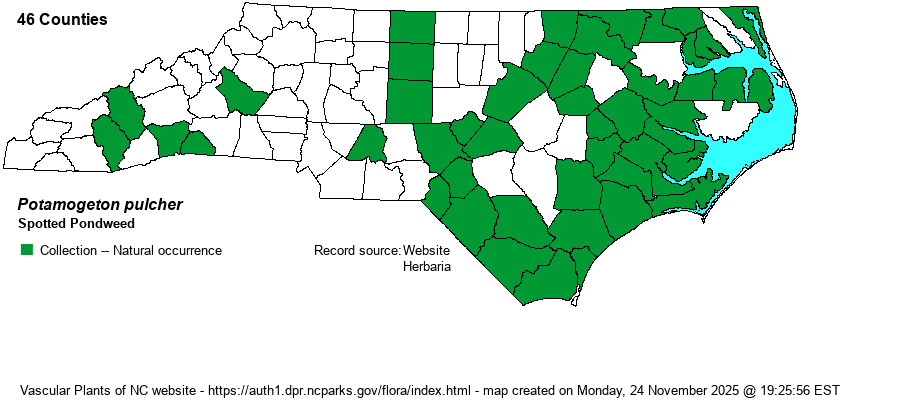| Author | Tuckerman | |
| Distribution | Throughout the Coastal Plain and the eastern edge of the Piedmont. Widely scattered in the rest of the Piedmont and southern Mountains, but seemingly absent in the central and northern Mountains and most of the northwestern Piedmont.
This is an Eastern species, ranging from southeastern Canada south to northern FL and eastern TX. It is most frequent along the Atlantic Coastal region from NH to SC.
| |
| Abundance | Fairly common to common in the Coastal Plain and extreme eastern Piedmont. Uncommon and local in the rest of the Piedmont and the southern Mountains. This is likely the second most common pondweed in the state, after P. diversifolius. | |
| Habitat | This species grows in typical habitats for pondweeds -- still or very slowly-moving waters such as pools, ponds, lakes, ditches, and sluggish creeks. Water chemistry varies from acidic to mildly alkaline. |
| Phenology | Flowers and fruits from June to September. | |
| Identification | This is a rather short species, seldom more than 1.5 feet long, with both submerged and floating leaves. The stem usually has no or very few branches and has black spotting. The submerged leaves are lanceolate or narrowly elliptical, about 4-5 inches long but only 3/4-inch wide, with entire but wavy margins. The floating leaves are rather large (much larger than those of P. diversifolius), being elliptical to ovate, about 2.5 inches long and 1.5 inches wide, with broadly rounded bases. These leaves contain many nerves (15-21), and the petioles are long (about 2.5-3 inches long), stout, and black-spotted. The spikes are densely flowered, cylindrical, and about 1.5 inches long. This familiar species should be readily told by the black-spotted stems (and petioles) and the strongly wavy ("crisped") margins of the submerged leaves. | |
| Taxonomic Comments | None
| |
| Other Common Name(s) | Heartleaf Pondweed | |
| State Rank | S4 [S4S5] | |
| Global Rank | G5 | |
| State Status | | |
| US Status | | |
| USACE-agcp | OBL link |
| USACE-emp | OBL link |

